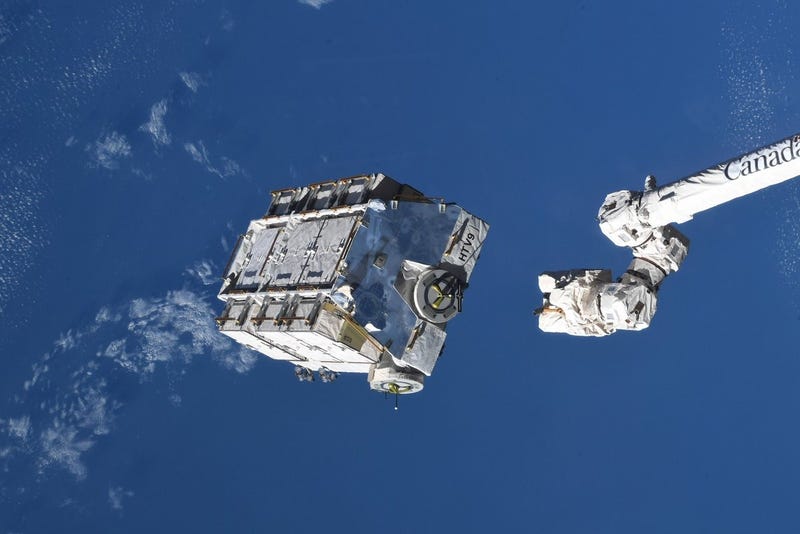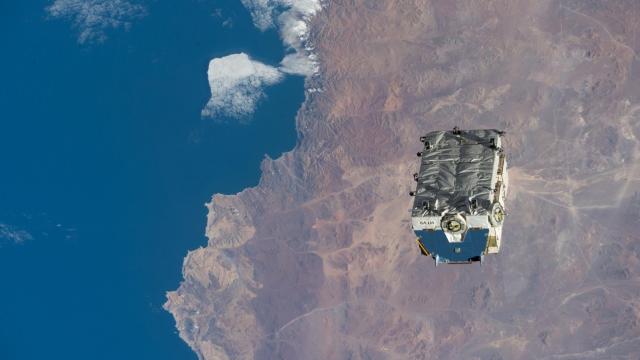A 2.9-ton cargo pallet, once used for a critical battery upgrade mission on the International Space Station (ISS), is now approaching the end of its journey and is expected to reenter the Earth’s atmosphere in the coming days.
The pallet, tossed from the ISS in March 2021 by the trusty Canadarm2, is facing imminent destruction in Earth’s atmosphere three years after serving its purpose in a major battery replacement project on the station. According to Harvard-Smithsonian astronomer Jonathan McDowell, the pallet “will not totally burn up on reentry—about half a ton of fragments will likely hit the Earth’s surface,” McDowell noted on X.
It’s the end of the orbital road for the heaviest piece of ISS space trash, which has been gradually falling towards Earth like a fly getting sucked up in a kitchen drain. The expected reentry of the cargo pallet into Earth’s atmosphere is between March 8 at 7:30 a.m. ET and March 9 at 3:30 a.m. ET, according to McDowell. The exact location of reentry is not known.
The pallet “was the largest object—mass-wise—ever jettisoned from the International Space Station at 2.9 tons, more than twice the mass of the Early Ammonia Servicing System tank jettisoned by spacewalker Clay Anderson during the STS-118 mission in 2007,” NASA spokesperson Leah Cheshier told Gizmodo in March 2021. The pallet was roughly 265 miles (427 kilometers) above Earth’s surface when it was released.
The pallet’s journey started with a mission to upgrade the ISS’s power system. In May 2020, a Japanese cargo ship docked at the ISS, delivering the SUV-sized equipment pallet to assist astronauts in replacing the old nickel-hydrogen batteries with new, more efficient lithium-ion batteries. This upgrade was a part of a larger effort, which concluded with a spacewalk on February 1, 2021, by astronauts Mike Hopkins and Victor Glover. This mission, involving four supply missions from the Japanese H-II Transfer Vehicle (HTV) cargo spacecraft, 13 different astronauts, and 14 spacewalks, saw the replacement of 48 nickel-hydrogen batteries with 24 lithium-ion batteries across six years. These batteries store energy collected by the station’s solar arrays.

The uncontrolled disposal of the pallet, however, was not part of the original plan. It was made necessary by a disrupted spacewalking schedule following the failed launch of a Soyuz rocket in 2018, which forced NASA astronaut Nick Hague and Roscosmos cosmonaut Alexey Ovchinin to make an emergency landing in the Kazakh steppe. This event led to a backlog in the disposal of such equipment. Normally, old batteries would be placed inside an HTV and jettisoned from the ISS to burn up on re-entry.
However, in late 2018, an HTV departed without this battery pallet due to the rescheduled spacewalks. As the battery replacement mission continued, and with no more HTVs of the old design expected to arrive (they are being replaced by the HTV-X cargo spacecraft), the decision was made to jettison the pallet independently.
Which brings us to the pending uncontrolled reentry. It marks the conclusion of this story—assuming the falling pieces don’t hurt anyone or damage any property—but it serves as a reminder of the challenges and complexities inherent in managing and adapting space missions.
